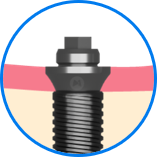Prosthetic Design Parameters
Understand the design envelope of each final Nexus prosthetic to better plan, execute, and fundamentally restore your patient’s smile.
Select an icon below to jump to a specific section.
Interocclusal Minimums
Interocclusal space is measured from the highest point on restoring tissue to the opposing occlusal plane.
Closest Tissue/MUA
Minimum Interocclusal Space
Occlusal Table
| PROSTHETIC | OPPOSING | INTEROCCLUSAL (MM) |
|---|---|---|
Single Arch |
• Existing Natural Dentition | 6-7mm Per Arch |
| • Tissue-Borne Denture | ||
Dual Arch |
•Zirconia | 7-8mm Per Arch |
| • Acrylic | ||
| Bruxer Patient Single Arch  |
• Existing Natural Dentition | 8-9mm Per Arch |
| Bruxer Patient Dual Arch  |
• Zirconia | 8-9mm Per Arch |
| • Acrylic |
Inter-Implant Distance
Inter-implant distance is meaured from the edge of the placed multi-unit abutment.
Minimum inter-implant distance: 2mm
Maximum inter-implant distance: 25mm
Maximum Implant Divergence (Path of Insertion)
The maximum angle of divergence between any two multi-unit abutments in an arch cannot exceed 45°
Severe angulation may be corrected with angled-MUA selection.
If uncorrected, bars will not seat due to path of insertion.
Cantilever (Fixed Prosthesis)
Nexus fixed final prosthetics can accommodate a maximum cantilever of 15mm.
Prosthetics with larger cantilevers will fall out of standard design parameters and may void warranty.
Multi-Unit Abutment Selection (Recommendations)
Implant placement and subsequent multi-unit abutment selection should aim to maximise restorative space.
SUBGINGIVAL
The best outcome to maximise restorative height is 1mm or more below the tissue.
Prosthetic bar will include a chimney to meet the Multi-Unit into the tissue.
EQUIGINGIVAL
Necessary to ensure hygienic prosthetic design and convex bar shape on the intaglio surface.
SUPRAGINGIVAL
MUA’s proud of the gingiva will reduce the restorative space and require the prosthesis to be raised significantly off the tissue, or require a concave design.















